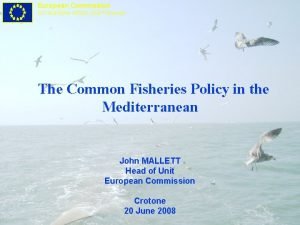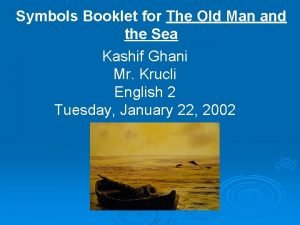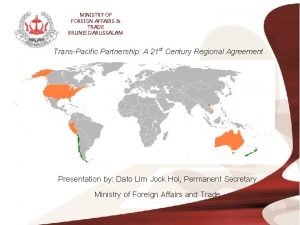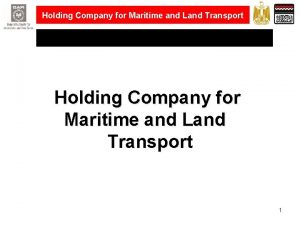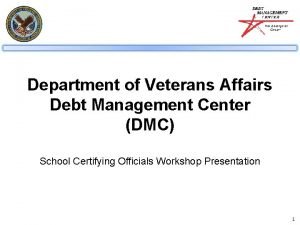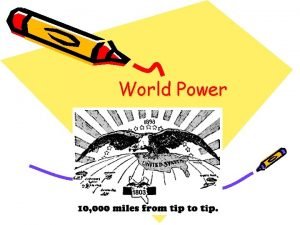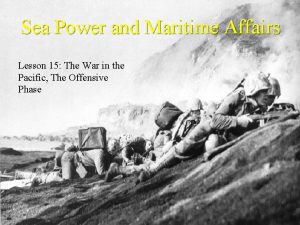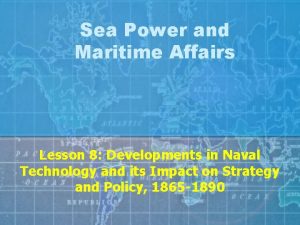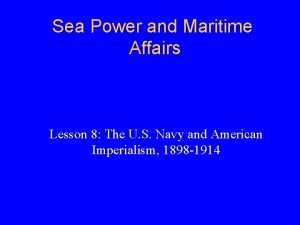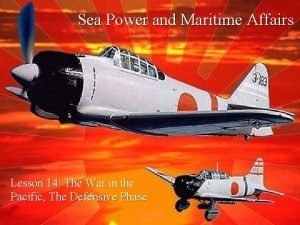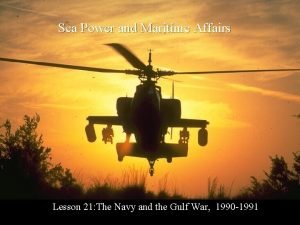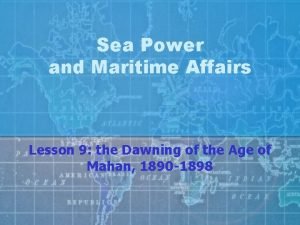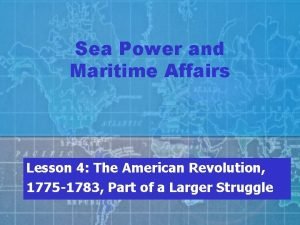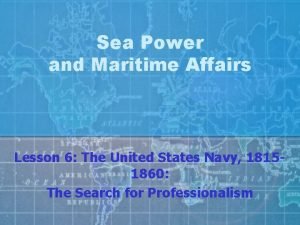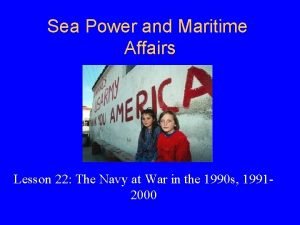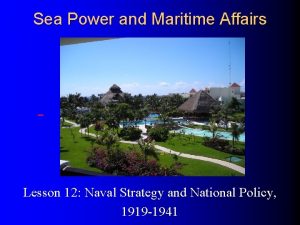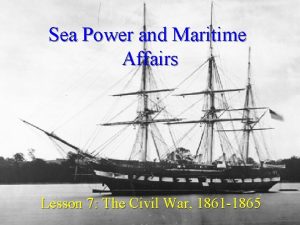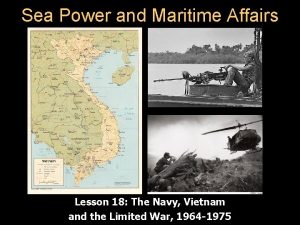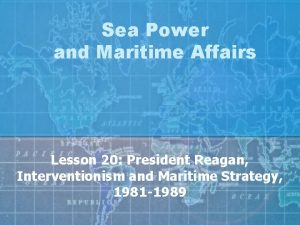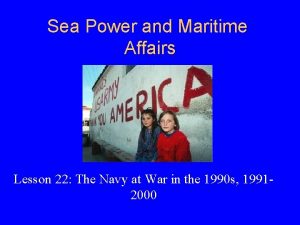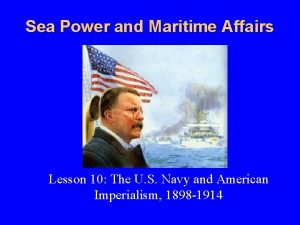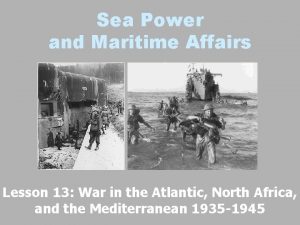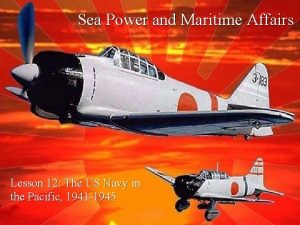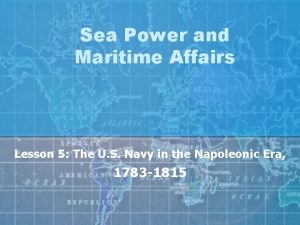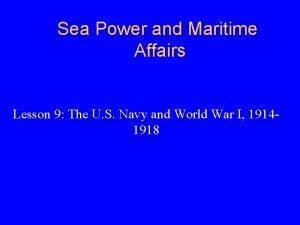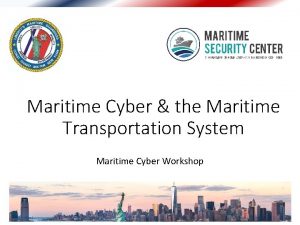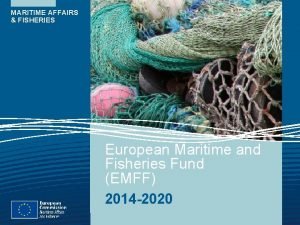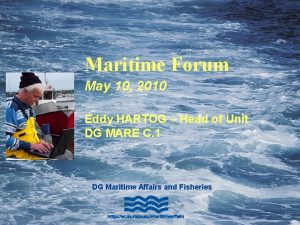Sea Power and Maritime Affairs Lesson 2 Sea























































- Slides: 55

Sea Power and Maritime Affairs Lesson 2 Sea Power in the Ancient Mediterranean World, from the Phoenicians to the Battle of Lepanto (1571)

Learning Objectives: • The student will comprehend the importance of sea power and navies to the peoples of the Mediterranean basin during antiquity. Special emphasis will be placed on Crete, the Phoenicians, Persia, Greece, Rome and the Italian city-states of the Middle Ages and early Renaissance • The student will understand the crucial role of the galley in naval warfare up to the Battle of Lepanto (October, 1571).


EXHIBIT A: AN ANCIENT GALLEY

Remember our Themes: • The Navy as an Instrument of Foreign Policy • Interaction between Congress and the Navy • Interservice Relations • Technology • Leadership • Strategy and Tactics • Evolution of Naval Doctrine

Remember our Themes: • The Navy as an Instrument of Foreign Policy • Interaction between Congress and the Navy • Interservice Relations • Technology • Leadership • Strategy and Tactics • Evolution of Naval Doctrine

Mediterranean Sea Power Milestones: • Crete Develops 1 st Navy (2500 – 1200 B. C. ) • The Phoenicians (2000 – 300 B. C. ) develop a seafaring empire • Early Greek Sea Power / The Greco-Persian Wars (492 B. C. – 480 B. C. ) • The Rise and Fall of Roman Sea Power (264 B. C. – c 410 A. D. ) • Sea Power during and after the Pax Romana (27 B. C. – 1500 A. D. ) • The Battle of Lepanto (1571)

Early Mediterranean Navies: • Water transportation was cheaper than overland routes, and especially in the Mediterranean basin. • The Mediterranean Sea was the natural locale for much of the war fighting that resulted the commercial/national/ethnic rivalry that characterized the ancient world. • From the outset, commercial or trading vessels were lumbering sailing ships; naval vessels were galleys.

Age of Galleys Circa 2, 000 BC until the 16 th Century

Galley Warfare: • Need for defense of merchant shipping gives rise to a new type of ship, the galley. Propulsion Weapons Formation Primary Oars Infantry Line-Abreast Secondary Sails Rams/Projectiles N/A There was no true naval doctrine. Battles were fought with a landbased mindset—primarily infantry and ramming--and there was no destruction from afar.

A Typical Galley

A Greek Trireme


Greek Trireme: - Galley with 3 banks of oars

Principal Functions of Navies: 1. Protect sea trade routes. 2. Block or disrupt enemy’s sea trade routes. Command & Control of the Sea 1. Defend against sea-borne attack 2. Isolate the enemy’s land forces 3. Carry the attack across the sea to the enemy

Line Abreast Formations: - Battles at sea were fought primarily as infantry battles

Line Abreast Formations

Line Abreast Formations Naval infantry used to board and capture enemy galleys.

Use of the Ram

Use of the Ram

Use of the Rams used to sink or immobilize enemy galleys.

Early Naval Powers • The Greeks • The Persians • The Romans

Early Naval Powers: Crete: • First maritime-oriented civilization - use of the sea • World’s first Navy established (Circa 2, 000 BC). • Mahanian geographical position • Natural resources- copper ore

Early Naval Powers: Phoenicians • Seafaring peoples in eastern Mediterranean • Colonies in southern and western Mediterranean


The Greco-Persian War (c. 492 -480 B. C. ): Status of Greece: • By 5 th century B. C. , Greeks dominated Black and Aegean Seas and held trading monopoly on eastern Mediterranean. • The Greeks exported olives, wine, and products of their gifted artisans and craftsmen, establishing settlements and colonies as far away as the north shore of the Black Sea and Spain. • The Greeks were chronically weakened by divisions into warring city-states.

POP QUIZ: This modern country was once known as “Persia”?

HINT: check out 2400 years of this country’s progress… THEN… AND NOW.

WHAT IS IRAN? (I’ll take pesky, fanatical thirdworld countries for 200. . . )

The Greco-Persian War (c. 492 -480 B. C. ): Background of Persia: - Persia, a unified kingdom and empire, overwhelmed Phoenicians, Egyptians and all others in its path -The Persians were attempting to expand their massive empire, and by 492 B. C. they faced determined resistance from the Greek citystates to further expansion into Europe. - The Persians easily conquered the Phoenicians, who were then conscripted to supply naval power for the advancing Persian armies. The Phoenicians supplied ships, men and shipbuilding facilities. - The Persian advance was effectively an attack on Europe by Asia; the conquering of the Greeks would have effectively eliminated the basis for western civilization as we know it.

Map of Eastern Mediterranean MAP OF EASTERN MEDITERRANEAN SEA & SURROUNDING AREAS

Three Major Campaigns: 492 BC: • Storm destroys Persian fleet. • Persians unable to supply their vast army without shipping; 2/3 of Persian Army returns to Persia for the winter • 50, 000 troops left behind were slaughtered before reinforcements arrived 490 BC: • Defeated by Athenians at the Battle of Marathon (amphibious invasion) • 10, 000 Greeks marched from Athens—not bothering to wait for their Spartan allies—and threw Persians back into the sea POP QUIZ: How far is it from Athens to Marathon? (a) 23 miles (b) 26 miles 285 yards (c) 42 miles

King Xerxes versus Thermistocles: • After a 10 year hiatus, King Xerces musters an army of 150, 000 men and renews attacks against the Greeks in 480 B. C. ) • Thermistocles (Greek politician) rallied Greeks to build 200 -ship Navy • Opening Action: The Battle of Thermoplylae (150, 000 Persians v. 300 Spartans)

RUMBLE IN THE MEDITERRANEAN: V. • Thermistocles knew why this <expletive deleted> course is important! • He knew that the Persians could not fight without a seaborne supply system • Mahanian Principle: “Communications dominate war”

Battle of Salamis – 480 BC:

The Battle of Salamis (480 B. C. ): • 310 Greek triremes stood against 600 Persian galleys in the constricted bay of the Island of Salamis. • Thermistocles used a double agent to trick Xerxes • • • Technology: bronze rams by Greeks to great advantage • • • Salamis was absolutely decisive and a classically Mahanian sea battle. The battle for the West was won: the Persians lost at least 200 Triremes; no Persian invader ever again entered Greece With insecure sea-borne lines of communication (SLOC), Xerxes retreated back to Asia Minor. Greeks soon reopened all sea lanes of communication to Bosphorus and Black Sea. Dominance in Greek alliance passed to Athens, which then established an empire or confederation based exclusively on sea power.


The Persians were later conquered by the armies of Alexander the Great… (But that is another story)

Roman Sea Power (c. 264 -410 A. D. ):

The Punic Wars: Romans v. Carthaginians (264 -201 B. C):

Roman Galley Corvus: Boarding device. - Allowed Roman soldiers to board Carthaginian ships. Corvus


Punic Wars (264 -201 B. C. ) • Goal: domination of Sicily • 1 st Punic War: Roman corvus tactics prevail, but Carthage is not destroyed • 2 nd Punic War: Hannibal marches through Spain to attack Italy, prompting Mahan to write his hoary volume of naval lore: what if Hannibal had control of the seas and had attacked accordingly. Ultimately, Rome destroys Carthage and burns all of its ships.

Roman Navy: • Remained second to Roman Army, but… • Enabled Roman empire to expand east to the Caspian Sea and Persian Gulf. • Cleared the Mediterranean Sea of pirates. • Adapted Roman Army’s missile tactics: use of catapults to hurl stones, javelins, and combustible projectiles.

Roman Civil Wars: • Fascinating events, including Cleopatra and Mark Antony sailing into battle together (Please feel free to read about this if you are interested. )

Mediterranean Sea Power After Pax Romana (p. s. – The Pax Romana, or “Roman Peace” was from 27 B. B. to 410 A. D. )

The Players and the Action • • Roman Empire divided between East and West • Germanic barbarian invasions of the West • Byzantine Empire continues in the East Crusades (1095) • Last 2 centuries • Crusaders are transported by merchant ships from Italian city-states, few naval battles Vikings - Invasions of Europe from Scandinavia in 900 s Venice establishes itself as the premier sea power in the Mediterranean by 1381 and maintained that role for more than 200 years

The Ottoman Empire: Challenges Venetian control of the Mediterranean Sea.

The Final Muslim Invasion of Europe: • The powerful Ottoman Turks make one final play to conquer the West, but the Venetian Navy stands in the way • The war is a classic stalemate between a land power (Turks) and a sea power (Venetians) • The culmination was the Battle of Lepanto (1571)

Battle of Lepanto (1571): • Last battle of the Age of Galleys • Combined Christian fleet defeats Ottoman Turks • Use of cannon mounted on front of galleys to supplement naval infantry • Sea battle of epic proportions, 80, 000 men on each side, 25, 000 Muslims and 8, 000 Christians killed. • Ottoman Empire’s domination of Mediterranean ends. • “Barbary” system remains in North Africa. (European powers forced to pay tribute for safe passage)

Battle of Lepanto:

Transitions • Battle of Lepanto last galley battle • Shift from the Mediterranean to the Atlantic • Spain and Portugal • New Naval Ships • Galleon • Age of Mediterranean preeminence in European sea power ends

Why was today’s lesson important? We discussed the nature and practice of sea power in a closed body of water as exemplified by the ancient kingdoms and empires in the Mediterranean Sea. In studying this information, the student should consider and assess whethere are lessons to be learned from the experiences of antiquity that have some relevance to the current war on terrorism in the same region. Always remember our themes!

QUESTIONS? NEXT LESSON: The Age of Sail, Oceanic Sea Power and the Emergence of European Nation States

READING FOR NEXT CLASS: (The Spanish Galleon) Potter: chapter 1 (review) and chapter 2 (next topic)
 Ministry of maritime affairs and insular policy
Ministry of maritime affairs and insular policy Dg maritime affairs and fisheries
Dg maritime affairs and fisheries Sea vision maritime
Sea vision maritime Sea eight maritime services
Sea eight maritime services Foreign affairs in the young nation answer key
Foreign affairs in the young nation answer key Real power and reactive power
Real power and reactive power What is asias largest desert
What is asias largest desert Marlin symbolism
Marlin symbolism Public affairs and religious liberty
Public affairs and religious liberty Melanie northrop harvard
Melanie northrop harvard Ucf college of health and public affairs
Ucf college of health and public affairs Michigan department of licensing and regulatory affairs
Michigan department of licensing and regulatory affairs Hellenic ministry of education and religious affairs
Hellenic ministry of education and religious affairs Orange county arts and cultural affairs
Orange county arts and cultural affairs Ministry of foreign affairs and trade brunei
Ministry of foreign affairs and trade brunei Department of commerce and consumer affairs
Department of commerce and consumer affairs Ionian sea vs aegean sea
Ionian sea vs aegean sea Sea anemone jellyfish
Sea anemone jellyfish Sea stack sea arch
Sea stack sea arch Land empires vs maritime empire
Land empires vs maritime empire Holding company for maritime and land transport
Holding company for maritime and land transport Solar power satellites and microwave power transmission
Solar power satellites and microwave power transmission Actual power
Actual power Dispersive power of a grating is defined as
Dispersive power of a grating is defined as Hhs office of population affairs
Hhs office of population affairs Ministry of east african community affairs uganda
Ministry of east african community affairs uganda Ics academic year plan
Ics academic year plan Amtrak media relations
Amtrak media relations Va.gov/debtman
Va.gov/debtman Foreign affairs trouble the nation chapter 6 section 2
Foreign affairs trouble the nation chapter 6 section 2 Sjsu faculty affairs
Sjsu faculty affairs South carolina human affairs commission right to sue
South carolina human affairs commission right to sue Public affairs marketing
Public affairs marketing Political affairs internship borgen project
Political affairs internship borgen project Utsa va certification form
Utsa va certification form Regulatory affairs kpi
Regulatory affairs kpi Graduate academic affairs iit
Graduate academic affairs iit Post approval regulatory affairs
Post approval regulatory affairs Labour affairs officer esdc
Labour affairs officer esdc Don't be entangled with the affairs of this world
Don't be entangled with the affairs of this world Humphrey school of public affairs
Humphrey school of public affairs Sc human affairs commission
Sc human affairs commission Public affairs directorate oxford
Public affairs directorate oxford Simon conway current affairs quiz
Simon conway current affairs quiz Strategic public affairs
Strategic public affairs Pagbibigay proteksyon sa mga konsyumers
Pagbibigay proteksyon sa mga konsyumers Sample letter to minister of foreign affairs
Sample letter to minister of foreign affairs Public affairs networking
Public affairs networking Medical staff affairs
Medical staff affairs What is noninvolvement in world affairs?
What is noninvolvement in world affairs? Critical issues in student affairs
Critical issues in student affairs Vha directive 1123
Vha directive 1123 Everyday affairs
Everyday affairs Student affairs office
Student affairs office A national policy of avoiding involvement in world affairs
A national policy of avoiding involvement in world affairs European parliament legal affairs committee
European parliament legal affairs committee

